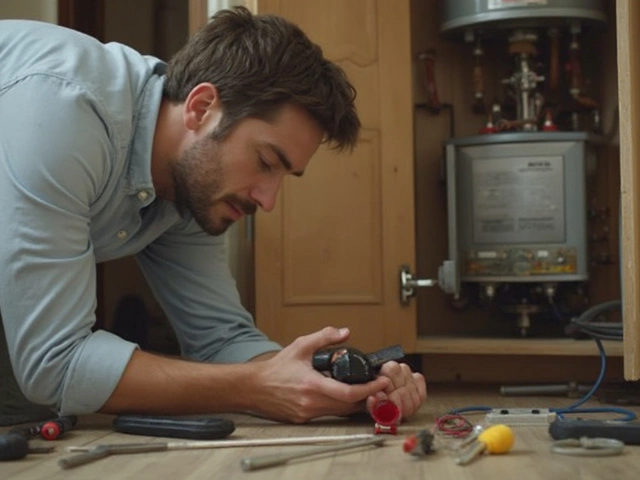Most folks barely think about their extractor fans—until the day one starts grumbling, clogging up with dust, or just plain gives up. Yet, these unsung heroes keep kitchens and bathrooms breathable, killing off condensation before it can turn into a mold party. That’s not just about comfort, either: bad air in a home can affect your health, rack up repair bills, and attract every mosquito for miles. So, do extractor fans actually need servicing? Let’s go deep on what regular care does for your fan, your home, and your wallet.
Why Extractor Fans Matter (and What Happens When You Ignore Them)
Extractor fans aren’t just spinning plastic discs for moving air around. They kick out steam, moisture, grease, and cooking smells—and if you have allergies or asthma, you really feel the difference. Let them get clogged or inefficient, though, and things get gross fast. A University College London field study found that unserviced bathroom fans often drop below 50% of their original airflow within just three years. You’ll notice your bathroom mirror fogs up, paint starts peeling, or a musty smell hangs around after a shower. In kitchens, a neglected extractor can become a sticky grease trap, attracting dust and even increasing risk of electrical fire. The cost of ignoring it? Repairs, potential mold remediation, and higher bills as your fan works harder for less effect.
If you take a quick tour of homes built in the last 25 years, nearly 80% have at least one extractor fan. Yet studies from the UK’s BRE Group report that most households go five years or more without cleaning or servicing them. This is one reason why homes start smelling as they age, or why tenants complain of endless condensation. And don’t forget energy bills: a blocked-up fan pulls more power for less airflow, wasting precious watts. One survey in 2022 even showed that poorly maintained fans account for up to 3-5% of unnecessary household energy use in older UK flats. That’s just the numbers—talk to anyone who’s spent weekends scrubbing black mold and you’ll hear the real-life headaches.
Signs Your Extractor Fan Needs Servicing
So, how do you know it's time to take action? First, listen. That rattling or grinding noise? It’s not part of normal operation. When fans get noisy, the bearings or motor might be struggling—likely because dust and debris are fighting their way in. Don’t ignore the volume creeping up. If your windows and mirrors fog more than usual, or the fan doesn’t feel like it’s pulling air, chances are the vents or louvres are blocked inside with fluff or cooked-on grease. Take a whiff, too: persistent smells in a bathroom or kitchen are a clue bad air is getting pushed around, not out. And if you spot black spots on the ceiling (that’s mold!) near your bathroom fan, servicing is overdue by months, if not years.
Another overlooked sign is a slow-starting fan. If it takes a few seconds to kick in (and you haven’t got a timer or humidity sensor model), that lag means either an electrical issue or a load of gunk inside the motor. Want to check airflow? Hold a piece of toilet tissue up to the vent. If it barely flutters or, worse, doesn’t hold at all, it’s cleaning time. Some modern extractor models have ‘clean filter’ indicator lights—don’t ignore them. Even the best extractor can jam with pet hair and towel lint or get its blades sticky just from everyday use. If you see visible dust caked on the grille, think of what you don’t see buried inside. These are all classic cases for servicing before you’re forking out for a new motor or risking a short circuit.

What Does Servicing Involve?
Servicing an extractor fan isn’t as intimidating as it sounds. Start simple: unplug (or switch off) at the fuse, then pop off the front cover. This is usually snapped or screwed on. You’ll be greeted by a dust colony—grab a vacuum and a damp cloth. Wipe down the blades, motor housing, and vent cover. For kitchen fans, a degreasing spray works wonders: soak, wipe, and rinse off all that sticky buildup. Most bathroom fans don’t need lubricating, but a drop of machine oil in the motor assembly can hush a grinding sound. Check for cracks in the cover or broken fan blades—a sure sign the fan needs either repair or a part swap.
For the best results, tackle filters too. Carbon or mesh filters in cooker hoods should be replaced at least twice a year if you cook often—or at minimum, every 12 months. This is where fans lose suction quickest, especially in open-plan flats. If your fan ducts out-of-doors, check the outside grille for leaves, bird nests, or spiderwebs. External blockages can turn even a spotless fan into a weakling. If you’re up for a thorough job, snap a picture of the wiring before removing anything so you don’t mix up connections. And don’t forget: while most folks clean the cover, it’s the hidden duct behind the wall that quietly fills with dust. This one may need a professional with flexible rods and brushes. Handy tip—while you’re cleaning, check out the rubber gaskets around covers or ductwork. Worn seals can drip condensation back into your walls or ceilings.
| Fan Location | Recommended Service Frequency | Common Issues |
|---|---|---|
| Bathroom | Every 6-12 months | Mold, lint buildup, noisy bearings |
| Kitchen | 6 months | Grease, reduced airflow, clogged filters |
| Utility Room | Annually | Dust, pet hair, vent blockages |
The Cost of Skipping Regular Servicing
What’s the risk of dodging extractor fan servicing? Let’s look at real numbers. In the past year, repair pros in the UK quoted average emergency callouts for non-working bathroom fans at £90, with full replacement creeping toward £220—versus £20-30 for a cleaning and filter change if you do it yourself. An Energy Saving Trust report found homes with clogged fans had mold-related repair bills averaging £250 per year after just two untreated years. Neglected kitchen hoods trap so much grease they can double cooking smells and actually raise your asthma risk. On top of that, a 2023 British Standards Institute survey showed fire brigades traced one in 12 small domestic kitchen fires to fans packed with old grease and dust. That’s not just hot air: fires, power trips, and ruined ceilings bring a mountain of hassle from a simple bit of neglect.
If you rent, ignoring your extractor can cost your deposit. Landlords increasingly check for clean functioning fans as part of property inspections, thanks to new health and safety rules in many cities. Not keeping up? You might pay for mold cleanup or damage after you move out. And if you’ve got kids or anyone with breathing troubles at home, there’s no shortcut. Dirty fans mean higher risk of spores and bacteria in the air—far worse than just a damp mark on the ceiling. A North England council survey even linked households with broken fans to increased rates of coughs and colds in winter months. Saving an hour a couple of times a year doesn’t weigh up against these risks.

Tips for Keeping Your Extractor Fan in Top Shape
Want to avoid all those headaches and bills? Regular extractor fan maintenance is easier than you might expect. Pick two weekends a year (spring and autumn are ideal) to run through your home’s fans. Always switch off the power first—whether you’re in the bathroom, kitchen, or anywhere else. Gently pop off the main cover to clean it, then vacuum and wipe the blades. If you have a kitchen hood, change or clean the grease filter every six months, and swap out charcoal filters in recirculating models at least once a year.
For bathroom fans, look for signs of moisture pooling around the casing—leaky ducts can signal blockages. If you notice the fan getting slow or extra noisy, try light lubricating oil on the motor spindle but never soak any electrical parts. If your fan vents outside, clean the external grille each year. Got a long ducted extractor? Twist a flexible dryer brush through from both ends to clear persistent dust. Homes with pets or people who smoke indoors should do this three times a year, minimum. If you spot cracks, worn seals, or corrosion, call a pro—replacing parts is cheaper before breakdown than full replacements. Pro tip: after a deep clean, run the fan for 10 minutes with the door/window closed to check airflow.
If you’re picking a new extractor fan, look for models with washable filters and easy-access covers, which make cleaning a five-minute job. Some newer units even have LED reminders for filter changes and built-in humidity sensors that automatically kick in—a real bonus if you always forget. In places with high humidity, leave the fan running for a few minutes after a shower or cooking, and leave doors cracked open to help air circulate. And don’t block vents with towels, kitchen clutter, or rogue laundry. A well-serviced extractor fan quietly works behind the scenes, making your home safer, healthier, and less smelly, with no drama.







